MARIANI’S
Virtual Gourmet
March
15, 2015
NEWSLETTER
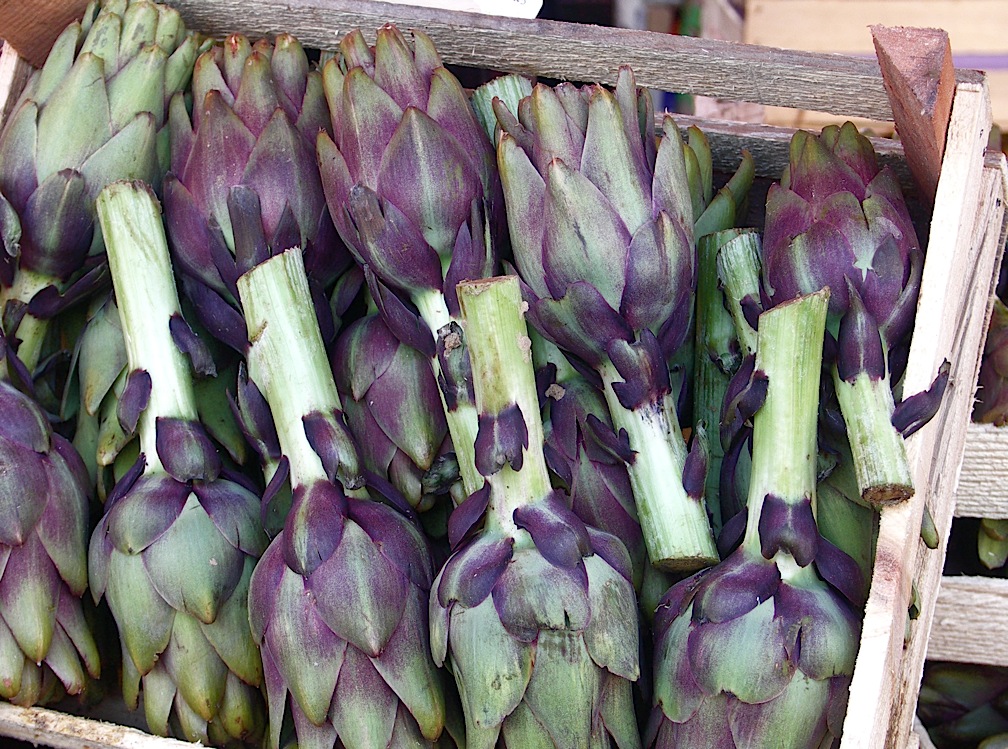
"Carciofi
Turinesi," by Galina Dargery (2013)
❖❖❖
IN THIS ISSUE
GRAND HOTEL TREMEZZO, LAKE COMO
By John Mariani
NEW YORK CORNER
Polo Bar
By John Mariani
NOTES FROM THE WINE CELLAR
WHAT I'M DRINKING NOW
By John Mariani
❖❖❖
GRAND HOTEL TREMEZZO, LAKE COMO
By John Mariani
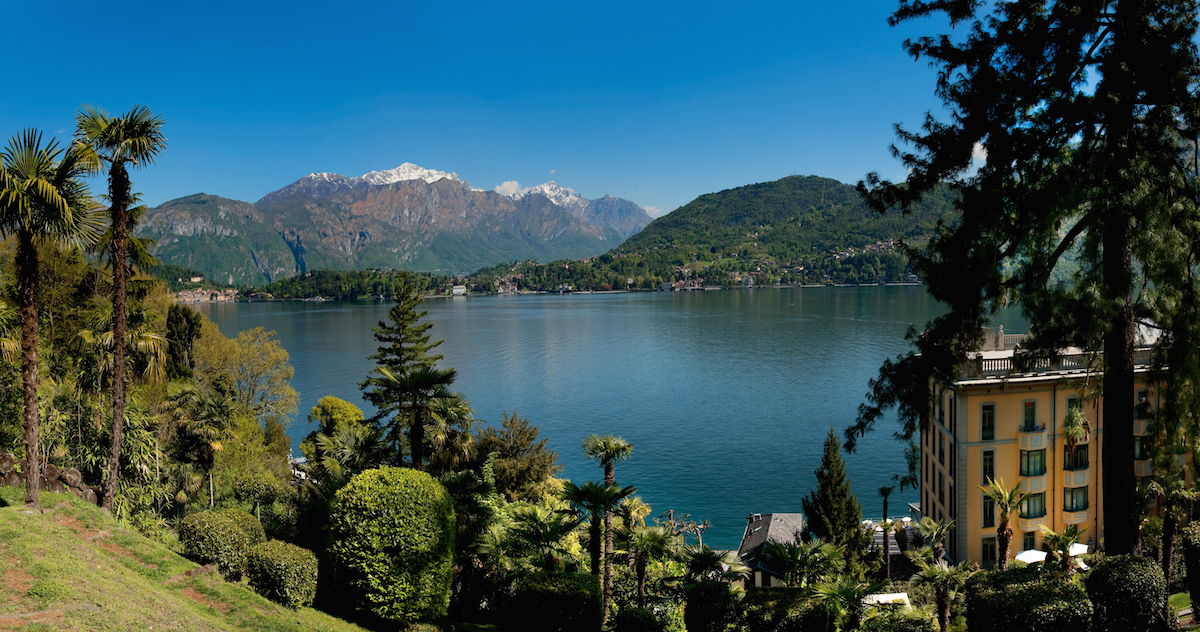
The Panorama from a Room at
A
great resort is an amalgam of ten thousand
details, most of them never even noticed by a
visitor too busy taking in the most obvious of
them. For
beyond the architecture of a grand hallway,
the panorama from one’s terrace, the rich
fabrics of the draperies, and the superb food
and wine, there are so many unnoticed details
that en masse enhance all the rest, from the
replacement of flowers in every vase to the
condition of every carpet, from the way tables
are set and the services performed as if by
silent magic. 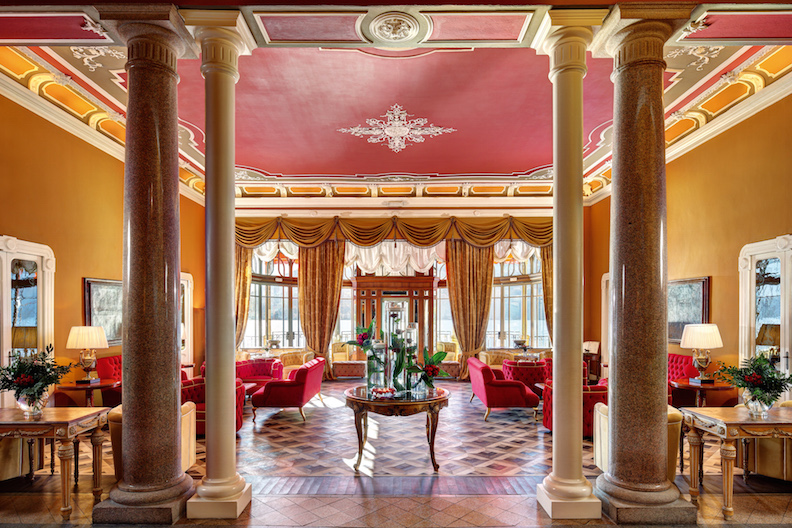
To take in every one of the details at
Grand Hotel Tremezzo
on the western shore of Italy’s
glorious Lake Como would take weeks and weeks at
your leisure,
so let me tell you of some of the unique
wonders of this exquisite place, which Greta Garbo’s
character in the 1932 film “Grand Hotel” referred to
as “that
happy, sunny place.”
(Her preferred room, now Number 113, is named
in her honor.)
The
hotel
dates to 1910 at a time when Europe’s leisure class
went on their grand tours for months at places like
the Villa D’Este and Serbelloni, but Enea and Maris
Gandola wanted something smaller, more secluded and
more intimate for guests, who, after World War I,
increasingly came to the area for health and sport.
In the 1930s ownership passed to the Sampietro
family, who managed to keep it open during World War
II, and the post-war growth of international
tourism, not least American, made Tremezzo famous as
a place of unpretentious luxury and Italian
savoir-faire.
The local De Santis family then
bought the hotel, and last year a granddaughter, the ebullient and very
sophisticated Valentina De Santis, was appointed
CEO to work on those ten thousand details and
bring a more youthful cachet to the property. There
is now a state-of-the-art spa and three swimming
pools. The rooms, each different, all with a view
of the lake, have LCD flat screen
satellite TV, free Wi-Fi, Aquae di Como toiletries, and
very large bathrooms; mine had a marble, six-foot
wide double sink in the center of the room, whose
wide window looked out over the water. She is even
experimenting with bed sheets created from processed wood
that have the softness and luxurious feel of
linens with the highest of thread counts. One
hundred service professionals keep all such
details impeccable.
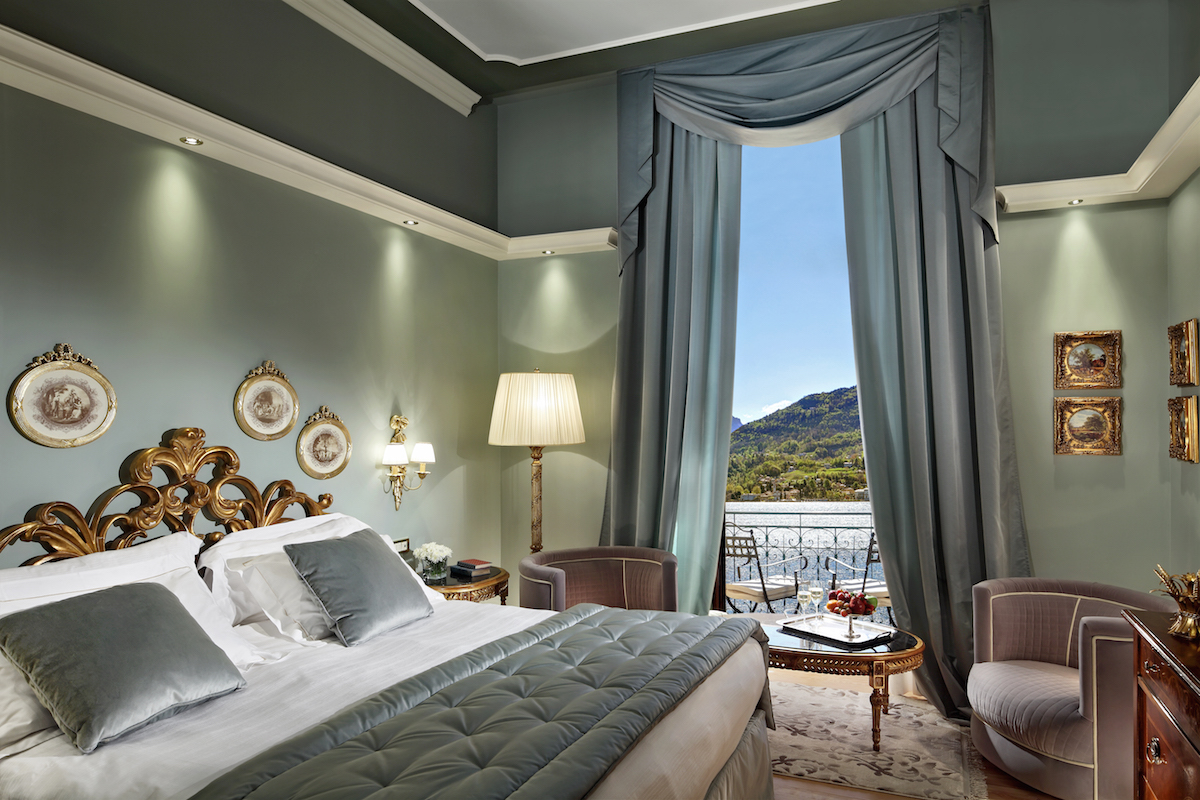 One
can drive from Milan to Grand Tremezzo in an hour,
but I prefer to arrive by water. A fast train to
Como then a smooth boat ride reveals all the majesty
of Italy’s lake region, past little towns and old
villas (including the rather modest one George
Clooney and his new bride, Amal, own). Arriving
at Grand Tremezzo, my bags were taken as I ascended
an elevator that opens onto the gorgeous art
nouveau-style lobby done (above) in vibrant colors of
fuchsia and ocher, with walls covered in silk. This
is not an atrium to dazzle you but to make you feel
warmly welcome.
A butler/concierge is located on every floor.
One
can drive from Milan to Grand Tremezzo in an hour,
but I prefer to arrive by water. A fast train to
Como then a smooth boat ride reveals all the majesty
of Italy’s lake region, past little towns and old
villas (including the rather modest one George
Clooney and his new bride, Amal, own). Arriving
at Grand Tremezzo, my bags were taken as I ascended
an elevator that opens onto the gorgeous art
nouveau-style lobby done (above) in vibrant colors of
fuchsia and ocher, with walls covered in silk. This
is not an atrium to dazzle you but to make you feel
warmly welcome.
A butler/concierge is located on every floor.
My room (left) was done in velvety,
dovelike shades of gray and gray-green, accented in
gold, with a terrace where it is possible to block
out the whole world except the mountains and flow of
Lake Como lighted by the soft Lombardian sun.
The extravagant breakfast buffet
in the Regina Room, with its own broad terrace, is
rich in everything from Italian cheeses and
charcuterie to a variety of breads, croissants and
jams, with eggs cooked to order and coffee brewed as
only Italians know how. By the time you come down for
breakfast, an array of international daily
newspapers will have been displayed in a library
with a remarkable collection of books on gardening. In fact,
the hotel itself is set adjacent to the Villa
Carlotta, now an art museum with a four-acre park.
I shall leave for another article
the attractions of the Lake Como area, crisscrossed
by ferries, and stay focused on reasons for staying
put at Tremezzo, which includes a splendid 19th
century, scarlet-colored billiards table. A floodlighted
clay tennis court overlooks the lake, Seven
golf courses are nearby, and bicycling along the
flat shoreline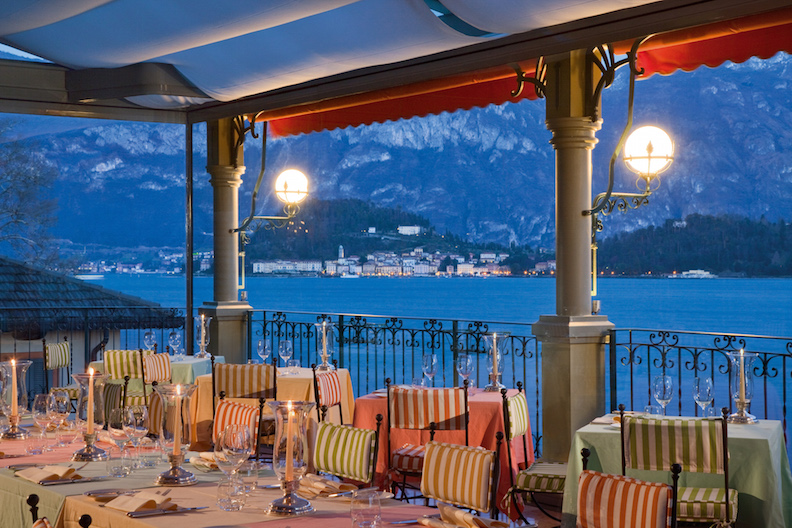 is a
capital way to see the area. Just
strolling or sitting among the azaleas and
bougainvillea should bring down one’s blood pressure
by ten percent.
is a
capital way to see the area. Just
strolling or sitting among the azaleas and
bougainvillea should bring down one’s blood pressure
by ten percent.
There
are three restaurants at Tremezzo, all of which
serve the hotel’s signature cocoa-and-almond cake
named Torta Valentina. All the food service is
overseen by Chef Osvaldo Presazzi, here since 1992,
after stints at illustrious restaurants like Les
Ambassadeurs at the Hotel Crillon in Paris, Il
Teatro in Milan, and the restaurants of master chef
Gualtiero Marchesi in Erbusco and Milan. Indeed,
for 2015, Signore Marchesi will be involved in the
development of menus for Tremezzo’s restaurants,
which will include his famous dish of risotto with
edible gold foil (below).
The fine dining room is called La Terrazza (right), with an
extensive menu of local and regional dishes drawing
as much as possible on the provender and larder of
the lake country and Lombardy. Thus, I
feasted on dishes like scallops with a sauce of lettuce (€32); foie gras
terrine graced with true balsamico
tradizionale (€32); ring-shaped  pasta called anelli
made into savory pancakes filled with ricotta and
spinach (€22); a luscious lobster and macaroni
(€48); roasted
young local rooster with potatoes and spring onions
(€26); most of the fish come right from the lakes.
Desserts far exceed what is usual in Italian
restaurants, and the menu is accompanied by an array
of fine regional wines. Sit there at twilight as the
staff lights the table candles, sip a negroni or
glass of Lombardian sparkling wine from
Franciacorta, and you may not get up from the table
till the moon finishes its rise in the night sky.
pasta called anelli
made into savory pancakes filled with ricotta and
spinach (€22); a luscious lobster and macaroni
(€48); roasted
young local rooster with potatoes and spring onions
(€26); most of the fish come right from the lakes.
Desserts far exceed what is usual in Italian
restaurants, and the menu is accompanied by an array
of fine regional wines. Sit there at twilight as the
staff lights the table candles, sip a negroni or
glass of Lombardian sparkling wine from
Franciacorta, and you may not get up from the table
till the moon finishes its rise in the night sky.
L’Escale (below) is a
casual, subterranean fondue and wine bar that also
offers a wide array of charcuterie and cheeses, as
well as meats and shellfish that you cook at your
own table. The
raclette (€22), made with Swiss cheese from the
Valais, is melted on a hot stone and eaten with
gherkins, while the fondue (€32-36) involves dipping
skewers of bread, fruit and meats into either melted
cheese or boiling oil. With red wine from the
Valtellina, this is a delightful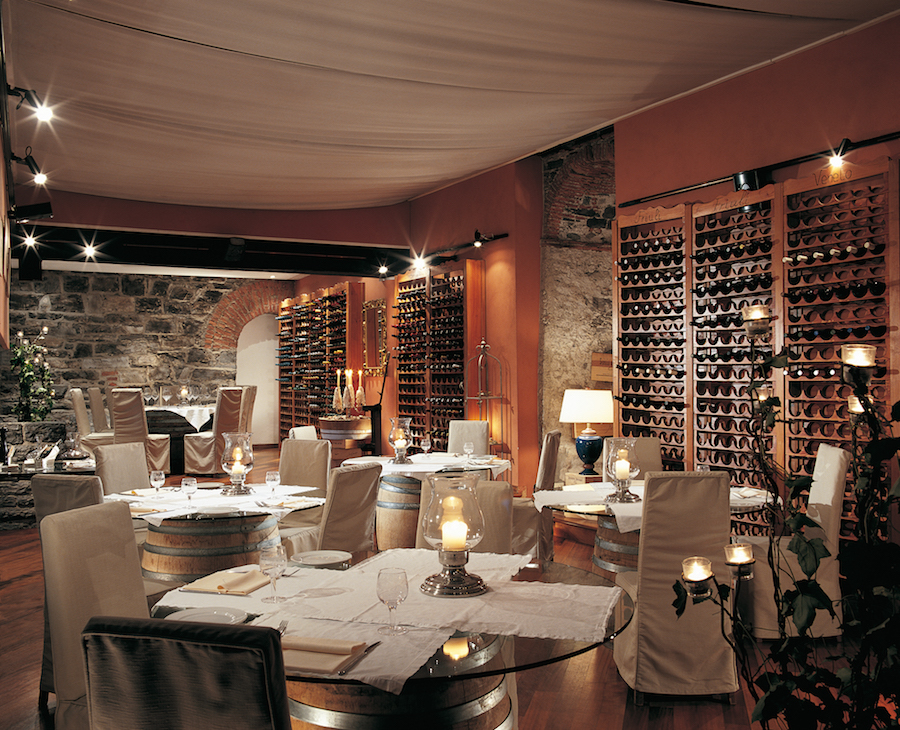 evening.
evening.
For snacks and pizzas there is
the TBar, and every Monday night they hold a
candlelit poolside pizza party that is extremely
popular.
Staying put in Grand Tremezzo,
with walks along the lake, a visit to Palazzo
Carlotta, and a sojourn down to the town of Como
can easily take up one's weekend. But the ferries
that crisscross the lake make exploring the area
easy and the sights are eye-opening--these I shall
be writing about in a future article.
You could, however, hardly be blamed for not
ever leaving the property of Grand Tremezzo for
days, for it is tempting to practice what Italians
call “dolce
far niente”--the sweetness of doing nothing. It’s an
art well worth learning in a place so sincerely
dedicated to that proposition.
Grand Hotel Tremezzo is located at Via Provinciale
Regina, 8, Tremezzina.
Phone:+39 0344 42491
❖❖❖
By John Mariani
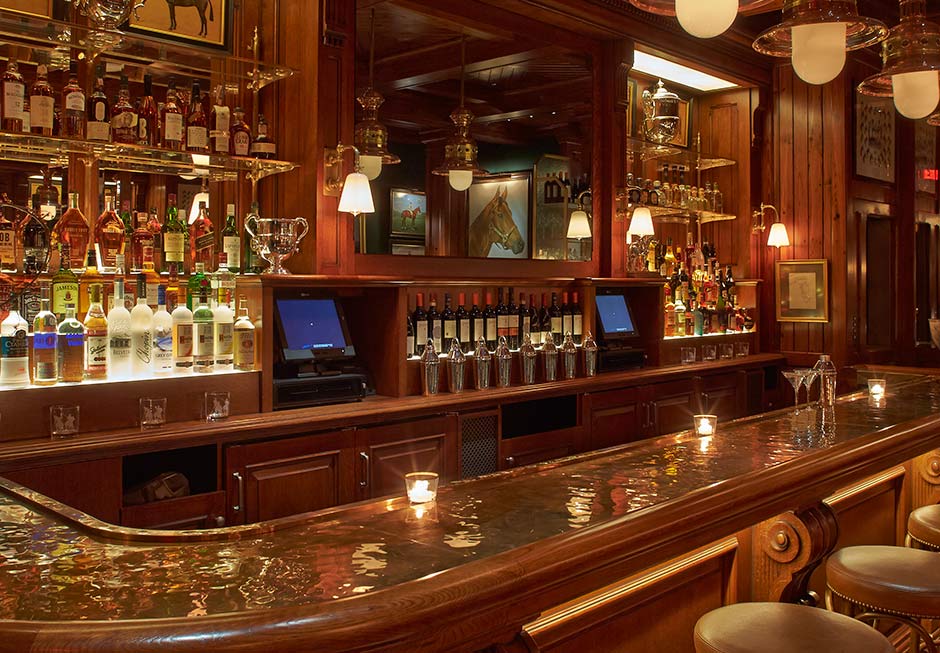 THE
POLO BAR
THE
POLO BAR 1 East 55th Street (off Fifth Avenue)
212-207-8562
The
polobar.com
Of course, there's been much clucking in the media about what kind of place it would be--long on promotional designs for his company, short on a commitment to fine dining.
Polo Bar, whose name reeks exclusivity, is
Lauren’s third restaurant (his first, RL, is in
Chicago; Ralph’s is in Paris), and, according to
its website, it is inspired by “classic New York
establishments” with dishes that are his “personal
favorites.” It's a fantasy that's part Scott
Fitzgerald, part Frank O'Hara, and part Peter
Arno, but with fresh polish. (Le
Bernardin's Eric Ripert has said the dining room
is "the best lighted restaurant in New
York.") Of course, the classic establishment
that leaps to mind upon entering Polo Club is `21’
Club, three blocks away across Fifth Avenue, whose
own décor includes some equestrian art and whose
menu set a template decades ago for the kind of
food power people want to eat, or at least order,
which includes a whole lot of red meat.
Ironically, for a nice Jewish boy from the
Bronx, née
Ralph Lifshitz, these were not the kind of
restaurants or clubs where Mr. Lauren would
have once been welcomed; in fact, the subterranean space of
Polo Club used to be home to the original La Côte
Basque, a notoriously snobbish WASP
watering hole (satirized in a famous short
story by Truman Capote) that opened after its French
owner at the time, Henri Soulé, refused ever
to give his landlord--fearsome Hollywood mogul
Harry Cohn--a good table at Le Pavillon
because he was Jewish; Soulé
thereupon lost his lease and opened La Côte Basque
nearby. Now, in the long tradition of the
American Dream, Mr. Lauren occupies the same space
with his own restaurant where he can come dressed
in RL jeans, even a cowboy hat, whenever he
wishes.
There’s plenty of saddle leather
at Polo Bar, the requisite Henry Koehler mural,
and expanses of woodwork that look as if buffed
with bees’ wax and lamb’s wool. There are charming
little lamps on the tables, signature green-rimmed
china, thick tablecloths, but, oddly, no flowers. Once inside, you
enter a
cramped brass-topped bar leading to a small,
intimate room with a fireplace a few steps up. Cocktails
are pricey: For  the $18
Ridgway Margarita you'd expect the bar would use
Cointreau rather than cheap curaçao. Bar food like
pigs in a blanket, shrimp cocktail and crudités
are available.
You half expect Don Draper and Roger
Sterling up there knocking back Manhattans.
the $18
Ridgway Margarita you'd expect the bar would use
Cointreau rather than cheap curaçao. Bar food like
pigs in a blanket, shrimp cocktail and crudités
are available.
You half expect Don Draper and Roger
Sterling up there knocking back Manhattans.
What is most impressive is that the entire staff acts as if they had been born on some Gold Coast in the 1920s and never aged a bit, well mannered, secure in their own loveliness. They appear to have just arrived from summer service on a Bermuda yacht or on a Wellesley spring break. How should you dress? Well, without pretense. This is not La Côte Basque.
The dining room is down a not very wide staircase (right), and it quickly occurred to me that no one but Ralph Lauren could get away with seating his darlings in such a subterranean, windowless space. The room works because its segments and alcoves are arranged so that those who need to see and be seen are not disadvantaged, even if some social climbers fret about which are the “A” tables. (I cannot imagine the agonies the receptionists must go through listening to people demanding tables when there are none and dropping names when their own are not enough to count.)
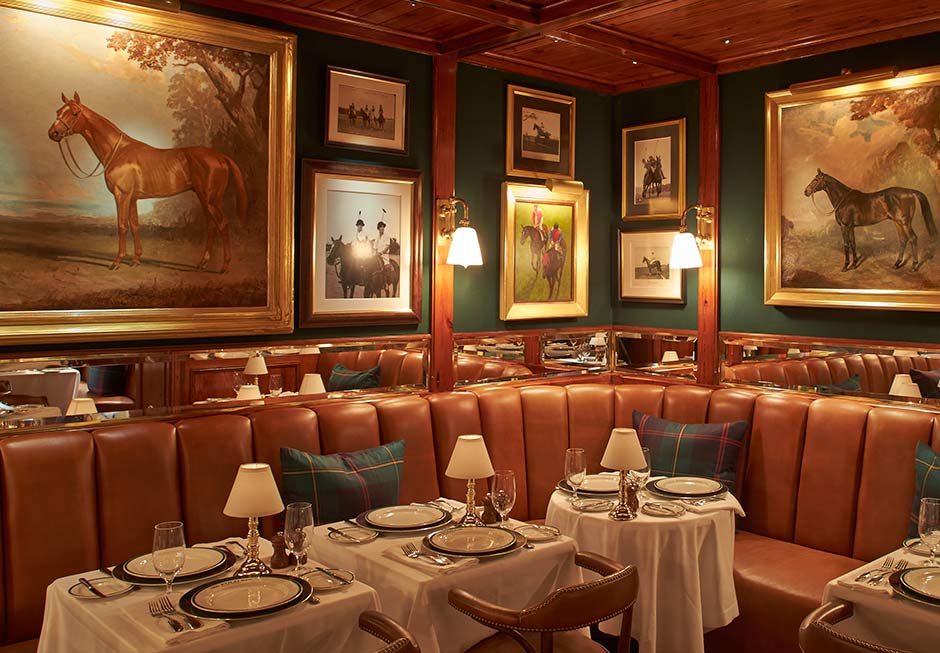 As
noted, the menu strikes no new ground in American
gastronomy, and Texas-born Executive Chef Sepp
Stoner probably hasn’t much leeway to develop his
own ideas just yet. But, with stints under Bob
Carter in Charleston, SC, and Laurent Tourondel in
NYC, he’s mastered the techniques that make mistakes
on such a menu a rarity.
As
noted, the menu strikes no new ground in American
gastronomy, and Texas-born Executive Chef Sepp
Stoner probably hasn’t much leeway to develop his
own ideas just yet. But, with stints under Bob
Carter in Charleston, SC, and Laurent Tourondel in
NYC, he’s mastered the techniques that make mistakes
on such a menu a rarity. You begin, as at Tourondel’s restaurants, with a fabulous, large cheese-enriched popover and good butter--fast becoming the bread roll of 2015--while you peruse a wine list that seems equally balanced between French (RL himself prefers Bordeaux) and California labels, and mark-ups range from very high among bottlings under $100 to more reasonable at the top levels. An Olivier Leflaive Meursault 1er Cru Charmes 2009 at $220 is almost a bargain.
The best of the starters I tried was the “ranch house chili” ($15) with a warm pecorino biscuit almost as good as that popover. Chockful of meat and a sensible amount of heat, the dish tells you that the chef was born in Texas. Butternut squash soup with wild mushrooms and sage ($13) was a good choice for a very cold winter’s night, but tuna tartare got a little lost mixed with avocado, mustard greens and crispy shallots with soy ginger dressing ($18).
The crab cake here is an oddity. When a high-end restaurant's menu in NYC lists a crab cake it means a fat hockey puck of jumbo lump crab loosely bound; at Polo Bar it comes as a rather flat round, thinly crusted with what tasted like shredded wheat and served with a mustard bell pepper sauce ($17).
In addition to four “Steaks & Burgers,” there are eight entrees labeled “classics,” including “Ralph’s corned beef sandwich on marble rye” ($22), which I hadn’t a chance to try, and a finely cooked, well-fatted Dover sole with a delicious lemon butter sauce, which at $54 is somewhat lower than others around town at similar restaurants.
The beef (sometimes, it’s said, from RL’s own ranch) is USDA Prime Angus, so I was surprised that the bone-in ribeye ($55), sliced a bit thin, did not have the flavor I would have expected and was decidedly chewy, which ribeyes shouldn’t be. It came with hand-cut French fries I had a hard time keeping my fingers away from. Sautéed garlic spinach was fine enough, and mashed potatoes with plenty of butter were irresistible.
An awful lot of items pin “Ralph” to their description—even “Ralph’s Coffee”—and that includes some very good coffee ice cream with dark chocolate shortbread cookies ($10). The brownie is, well, damn scrumptious, and the apple pie (“homemade”) with vanilla ice cream and warm caramel sauce ($10) is just barely bettered by the really excellent bourbon pecan pie with whipped cream ($14).
And so, Polo Bar is what it was intended to be, and that is, very attractive, extremely hospitable, a show case for RL style, and at the moment tough to get into—bookings are already a month out. In fact, New York Magazine spent 650 words of pouty text on just that aspect, and the NY Times contends--wink, wink--there is a secret e-mail contact. The food is dependable, of a kind your friends insist is surprisingly good at their country club but never is. Polo Bar’s food is far better than that, and if you don’t go out raving about it, there is plenty of appeal to a restaurant this carefully crafted.
Polo Bar is open for dinner nightly.
❖❖❖
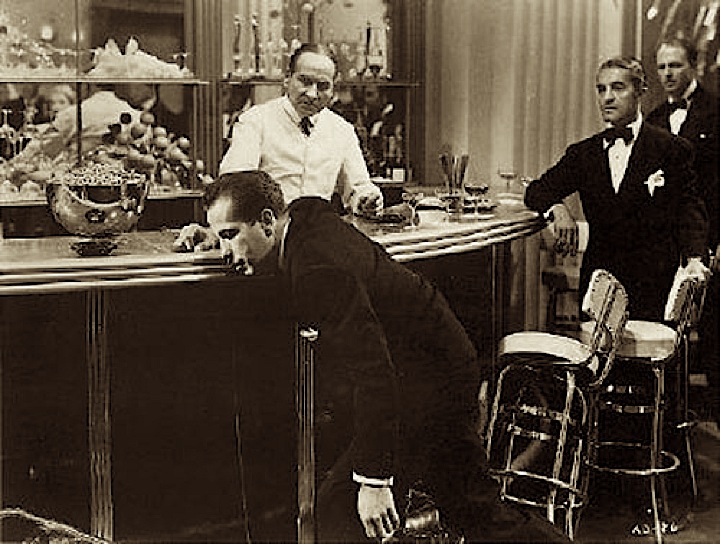 WHAT I'M
DRINKING NOW
WHAT I'M
DRINKING NOW By John Mariani
Nothing
makes drinking wine so appealing as the vast
array of good, solidly made wines at good price
points from all over the world. Here
are some I’m enjoying right now.
Rapsani 2012 ($6)—Greek
red wines have turned somersaults in quality over
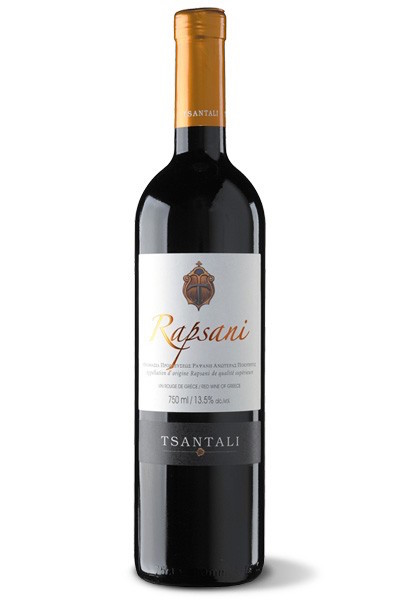 the past decade, and
whatever problems Greece must overcome
economically, the prices of its wines make them
very attractive.
This blend of organic grapes from northern
Greece—one-third each of Xinomavro, Krasato, and
Tavra—comes from Larissa. With
just 13.5% alcohol, it’s light- to medium-bodied,
and the blend shows itself in layers of flavors,
and the often harsh Xinomavro is tamed by the
other varietals.
the past decade, and
whatever problems Greece must overcome
economically, the prices of its wines make them
very attractive.
This blend of organic grapes from northern
Greece—one-third each of Xinomavro, Krasato, and
Tavra—comes from Larissa. With
just 13.5% alcohol, it’s light- to medium-bodied,
and the blend shows itself in layers of flavors,
and the often harsh Xinomavro is tamed by the
other varietals.
Beyerskloof Chenin Blanc-Pinotage 2014
($14)—A unique blend of 82% Chenin Blanc and 18%
Pinotage (a cross of Pinot Noir and Cinsault that
has been the most promoted of modern South African
winemaking), is a very pleasant marriage by
winemaker Beyers Truter, who calls it a “white
Pinotage.” It has well balanced sugars and acid
without the brash grassiness Chenin Blanc so often
shows on its own.
 SKW
Cabernet Sauvignon 2012 ($48)—From the
admirable Steven Kent Winery in Livermore Valley,
CA (left),whose
soils are similar to Bordeaux’s, comes this lovely
wine that shows that California vintners need not
pump up the alcohol (this one comes in at 13.6%)
to provide body.
You get plenty of heft and equal elegance
without overripe plumminess. It
could use a little more backbone perhaps, but it’s
a wonderful wine with every meat or most pastas.
SKW
Cabernet Sauvignon 2012 ($48)—From the
admirable Steven Kent Winery in Livermore Valley,
CA (left),whose
soils are similar to Bordeaux’s, comes this lovely
wine that shows that California vintners need not
pump up the alcohol (this one comes in at 13.6%)
to provide body.
You get plenty of heft and equal elegance
without overripe plumminess. It
could use a little more backbone perhaps, but it’s
a wonderful wine with every meat or most pastas.
Copain Pinot Noir “Les Voisins” 2012 ($42)—Here’s
a Pinot Noir from the coolest part of Anderson
Valley that shows you can share the best qualities
of Burgundy without giving up a wine’s California
terroir. There are lovely subtleties throughout,
punctuated with rich, deep, sunny flavors kept in
tandem at just 13.1% alcohol. It’s got years of
liveliness ahead but quite delicious now.
❖❖❖
Any of John Mariani's books below may be ordered from amazon.com.
 I'm proud and happy to announce that my
new book, The Hound
in Heaven (21st Century Lion Books), has just
been published through Amazon and Kindle.
I'm proud and happy to announce that my
new book, The Hound
in Heaven (21st Century Lion Books), has just
been published through Amazon and Kindle. It is a novella, and for anyone who loves dogs, Christmas, romance, inspiration, even the supernatural, I hope you'll find this to be a treasured favorite. The story concerns how, after a New England teacher, his wife and their two daughters adopt a stray puppy found in their barn in northern Maine, their lives seem full of promise. But when tragedy strikes, their wonderful dog Lazarus and the spirit of Christmas are the only things that may bring back his master back from the edge of despair.
WATCH THE VIDEO!
“What a huge surprise turn this story took! I was completely stunned! I truly enjoyed this book and its message.” – Actress Ali MacGraw
“He had me at Page One. The amount of heart, human insight, soul searching, and deft literary strength that John Mariani pours into this airtight novella is vertigo-inducing. Perhaps ‘wow’ would be the best comment.” – James Dalessandro, author of Bohemian Heart and 1906.
“John Mariani’s Hound in Heaven starts with a well-painted portrayal of an American family, along with the requisite dog. A surprise event flips the action of the novel and captures us for a voyage leading to a hopeful and heart-warming message. A page turning, one sitting read, it’s the perfect antidote for the winter and promotion of holiday celebration.” – Ann Pearlman, author of The Christmas Cookie Club and A Gift for my Sister.
“John Mariani’s concise, achingly beautiful novella pulls a literary rabbit out of a hat – a mash-up of the cosmic and the intimate, the tragic and the heart-warming – a Christmas tale for all ages, and all faiths. Read it to your children, read it to yourself… but read it. Early and often. Highly recommended.” – Jay Bonansinga, New York Times bestselling author of Pinkerton’s War, The Sinking of The Eastland, and The Walking Dead: The Road To Woodbury.
“Amazing things happen when you open your heart to an animal. The Hound in Heaven delivers a powerful story of healing that is forged in the spiritual relationship between a man and his best friend. The book brings a message of hope that can enrich our images of family, love, and loss.” – Dr. Barbara Royal, author of The Royal Treatment.
 |
The Encyclopedia of American Food and Drink by John F. Mariani (Bloomsbury USA, $35) Modesty forbids me to praise my own new book, but let me proudly say that it is an extensive revision of the 4th edition that appeared more than a decade ago, before locavores, molecular cuisine, modernist cuisine, the Food Network and so much more, now included. Word origins have been completely updated, as have per capita consumption and production stats. Most important, for the first time since publication in the 1980s, the book includes more than 100 biographies of Americans who have changed the way we cook, eat and drink -- from Fannie Farmer and Julia Child to Robert Mondavi and Thomas Keller. "This book is amazing! It has entries for everything from `abalone' to `zwieback,' plus more than 500 recipes for classic American dishes and drinks."--Devra First, The Boston Globe. "Much needed in any kitchen library."--Bon Appetit. |
"Eating Italian will never be the same after reading John Mariani's entertaining and savory gastronomical history of the cuisine of Italy and how it won over appetites worldwide. . . . This book is such a tasteful narrative that it will literally make you hungry for Italian food and arouse your appetite for gastronomical history."--Don Oldenburg, USA Today. "Italian
restaurants--some good, some glitzy--far
outnumber their French rivals. Many of
these establishments are zestfully described
in How Italian Food Conquered the World, an
entertaining and fact-filled chronicle by
food-and-wine correspondent John F.
Mariani."--Aram Bakshian Jr., Wall Street
Journal.
"Equal parts
history, sociology, gastronomy, and just
plain fun, How Italian Food Conquered the
World tells the captivating and delicious
story of the (let's face it) everybody's
favorite cuisine with clarity, verve and
more than one surprise."--Colman Andrews,
editorial director of The Daily
Meal.com. "A fantastic and fascinating
read, covering everything from the influence
of Venice's spice trade to the impact of
Italian immigrants in America and the
evolution of alta cucina. This book will
serve as a terrific resource to anyone
interested in the real story of Italian
food."--Mary Ann Esposito, host of PBS-TV's
Ciao
Italia. "John Mariani has written the
definitive history of how Italians won their
way into our hearts, minds, and
stomachs. It's a story of pleasure over
pomp and taste over technique."--Danny Meyer,
owner of NYC restaurants Union Square
Cafe, The Modern, and Maialino.
|
 |
 |
 |
 |
 |
 |
 |
 |
 Everett Potter's Travel Report:
Everett Potter's Travel Report: 
 Eating Las Vegas
is the new on-line site for Virtual Gourmet
contributor John A. Curtas., who since 1995
has been commenting on the Las Vegas food
scene and reviewing restaurants for Nevada
Public Radio. He is also the
restaurant critic for KLAS TV, Channel 8 in
Las Vegas, and his past reviews can be
accessed at KNPR.org.
Click on the logo below to go directly to
his site.
Eating Las Vegas
is the new on-line site for Virtual Gourmet
contributor John A. Curtas., who since 1995
has been commenting on the Las Vegas food
scene and reviewing restaurants for Nevada
Public Radio. He is also the
restaurant critic for KLAS TV, Channel 8 in
Las Vegas, and his past reviews can be
accessed at KNPR.org.
Click on the logo below to go directly to
his site.

Tennis Resorts Online: A Critical Guide to the World's Best Tennis Resorts and Tennis Camps, published by ROGER COX, who has spent more than two decades writing about tennis travel, including a 17-year stretch for Tennis magazine. He has also written for Arthur Frommer's Budget Travel, New York Magazine, Travel & Leisure, Esquire, Money, USTA Magazine, Men's Journal, and The Robb Report. He has authored two books-The World's Best Tennis Vacations (Stephen Greene Press/Viking Penguin, 1990) and The Best Places to Stay in the Rockies (Houghton Mifflin, 1992 & 1994), and the Melbourne (Australia) chapter to the Wall Street Journal Business Guide to Cities of the Pacific Rim (Fodor's Travel Guides, 1991).


MARIANI'S VIRTUAL GOURMET
NEWSLETTER is published weekly. Editor/Publisher: John
Mariani.
Editor: Walter Bagley. Contributing Writers: Christopher Mariani,
Robert Mariani, Misha
Mariani,
John A. Curtas, Edward Brivio, Mort Hochstein,
Andrew Chalk, Dotty Griffith and Brian Freedman. Contributing
Photographers: Galina Dargery, Bobby
Pirillo. Technical Advisor: Gerry McLoughlin.
To un-subscribe from this newsletter,click here.
© copyright John Mariani 2015

